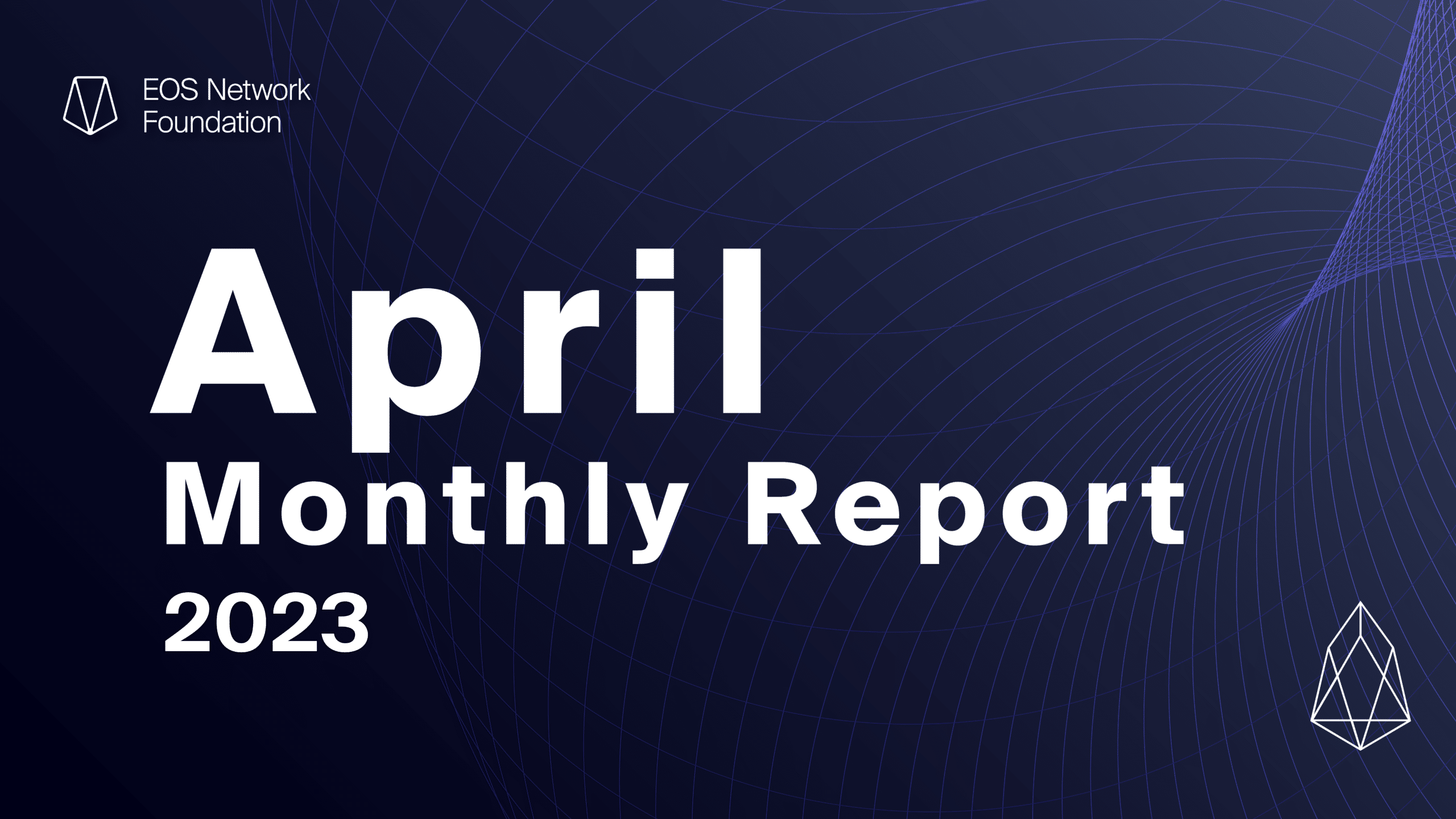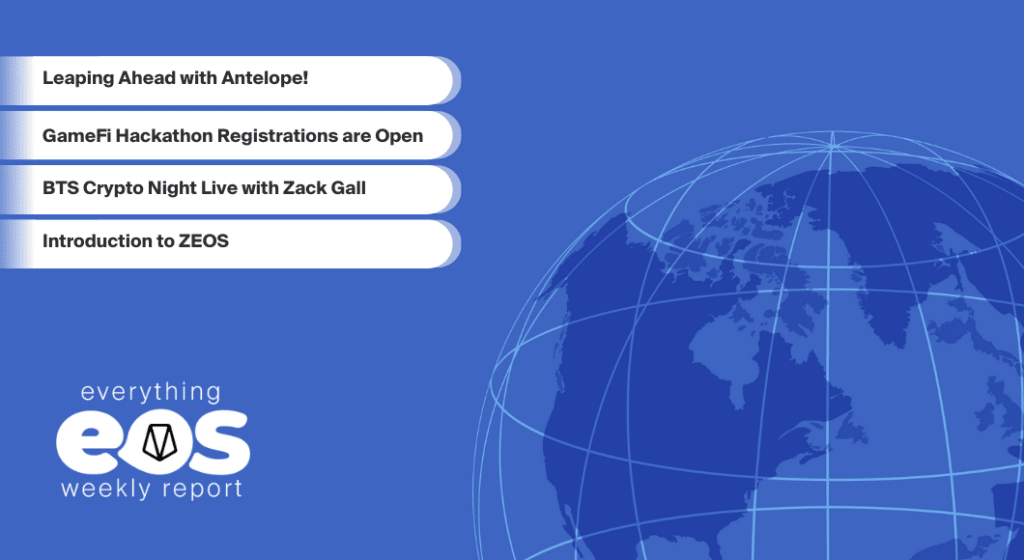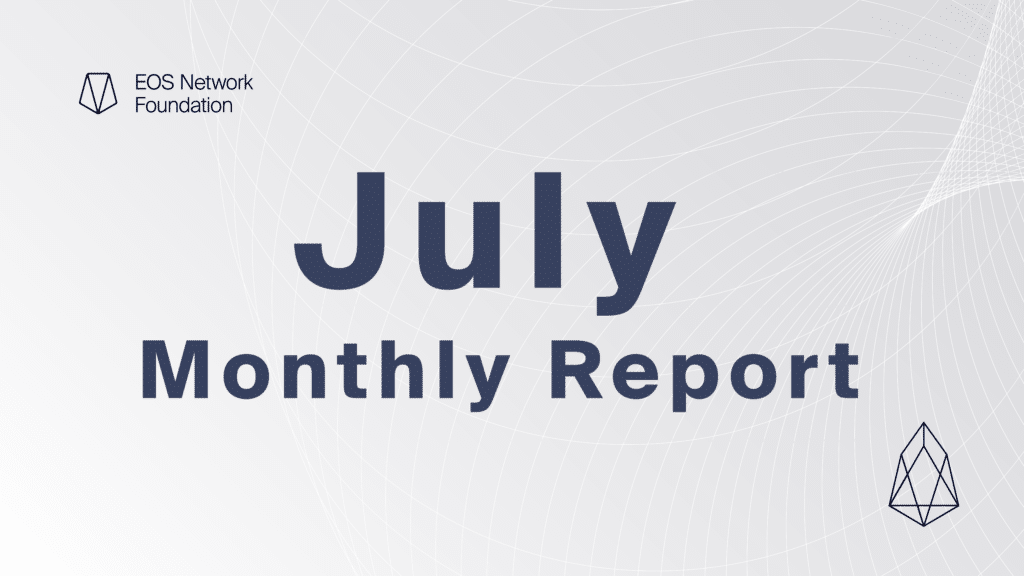Stay ahead of the curve with the Everything EOS Monthly Report, your go-to source for comprehensive and up-to-date news from the EOS ecosystem. Our report scours the furthest reaches of the EOS community to bring you the freshest updates and most compelling stories. Don’t miss a beat in the rapidly evolving world of EOS!
EOS EVM: Audit, Open Source & Webinar
On April 14, the EOS Network Foundation (ENF) announced the beta launch of the EOS EVM mainnet smart contract. This emulation of the Ethereum Virtual Machine (EVM) combines the robust libraries of the Ethereum codebase with the high-performance EOS Network.
The EOS EVM has been in development for over a year, aiming to be the most performant and compatible EVM on the market. It features one-second block intervals, 800+ swaps per second, and extremely low gas fees, and it passed a security audit with zero issues.
The EOS EVM has feature parity with the Ethereum EVM, meaning it can execute any function executable on Ethereum. Key features include a trustless bridge for seamless token movement between EOS native and EVM and a simple gas model using EOS tokens.
The trustless bridge enables token transfers without requiring third-party oracles or EOS native accounts. In the future, EOS EVM engineers plan to expand the bridging mechanism to support more tokens and are exploring future incentive models to encourage decentralization.
While EOS native does not have gas fees, the EOS EVM has incorporated them into its design. The EOS EVM’s gas model calculates usage like other popular EVMs, with fees split to cover various expenses, including token burns, rewards for validators, and operational costs.
The launch of the EOS EVM is a significant achievement for the EOS community, opening up the ecosystem to new developers, projects, and users. Check out the docs to find out more!
The EOS EVM is Now Open Source!
With the recent move to open source the EOS EVM, the EOS Network once again extends its legacy of free and open source development into the foundations of a Web3 future, for all. This significant development makes the EOS EVM available to all current and future Antelope based blockchains, and makes it easy for application developers to run their own RPC nodes, rather than relying solely on the ENF operated nodes. Read all the details in the tweet linked below.
Register for the EOS EVM Webinar
Head of Developer Relations, Nathan James is going to be part of an upcoming webinar, alongside ENF software Engineer, Matias Romeo, and our partners from Zaisan. Register to learn how the EOS EVM can help you bridge the best of both worlds! The webinar will also contain a live demonstration of deploying a Solidity smart contract on EOS EVM. Don’t miss this opportunity to learn from expert panelists about this highly sought-after feature for developers.
DWF invests $60M in EOS Network
DWF Labs, a global market maker and investment firm, has entered into a strategic partnership with the EOS Network Foundation (ENF) through an investment deal worth over $60 million. The partnership involves a $45 million EOS token purchase agreement and a $15 million commitment to invest in EOS-based businesses and projects to accelerate the growth and adoption of the EOS Network.
DWF Labs has been an active investor in the web3 space, making numerous investments during the crypto bear market. The partnership came as the EOS Network launched its enterprise-grade EOS EVM, which boasts over four times more swaps per second than Polygon, BSC, and Avalanche.
Yves La Rose, Founder and CEO of the EOS Network Foundation, said: “The collaboration with DWF Labs marks a significant milestone for the EOS Network. We are confident that this strategic partnership will enhance the adoption and visibility of the EOS Network and provide it with unparalleled support. Together, we will continue to drive innovation and growth within the EOS ecosystem.”
The partnership between DWF Labs and the EOS project unlocks new potential in the world of Web3. By combining their expertise and resources, both parties hope to ensure the EOS Network’s thriving and fruitful future.
April Events Highlights
EOS was back on the event circuit in April, with a presence at Consensus 2023 in Austin and the Hong Kong Web3 Festival. ENF team members regaled the fireside chat with their experiences, sharing tweets, videos, pictures, and other media.
At the Web3 Festival in Hong Kong, the ENF articulated their strategic vision and the myriad potential applications for the EOS Network. The city hosts tremendous opportunities for building Web 3.0 businesses as it positions itself as a premier crypto-friendly jurisdiction.
GameFi proved a particularly interesting subject for attendees. Gaming studios from the web 2.0 space are keen to leverage the benefits of blockchain technology, focusing on user onboarding and lowering the barrier to entry for users.
The EOS community and members of the Foundation also attended Consensus, beginning with a kick-off event on Tuesday, April 25, where the ENF joined the Blockchain Game Alliance, Upland and Telos for a casual networking event with food, drinks, and a short panel conversation about the future of gaming.
Since 2015 Consensus has served as an event for collaborating with professionals and builders worldwide. This year, the ENF has all hands on deck, connecting with upwards of 20,000 attendees. At its heart, Consensus is a call to action for developers, investors, founders, policymakers, brands and others to come together for the future of finance and the new digital economy.
You can get all the pictures, videos, interviews, and more in our Consensus recap below!
Chintai & Defibox are Powered by EOS
The EOS Network Foundation released two in-depth case studies this month, delving deep into how EOS projects Chintai and Defibox use the EOS Network.
Operating out of Southeast Asia, with a technology hub in Frankfurt and two financial licenses from the Monetary Authority of Singapore (MAS), Chintai uses the power of EOS and Antelope to provide digital asset issuance, regulatory compliance, and secondary market services for securities, bonds, real estate, carbon tokens, utility tokens, and more.
Chintai uses EOS to issue and distribute its native CHEX token, leveraging the network’s scalability, low transaction fees, and flexibility. The platform uses Antelope’s hierarchical account permissions to enable legal compliance, and EOS’s cross-chain compatibility enables seamless operation between private and public chains. With its reliability, affordability, and robust security, EOS helps make Chintai a reliable choice for businesses and individuals in the digital asset market.
Defibox is an all-in-one DeFi platform that addresses high transaction costs, slow transaction speeds, and limited cross-chain functionality in the DeFi industry. By integrating token swaps, staking, and lending, Defibox simplifies the user experience and enables users to access various DeFi services easily.
Defibox offers cost-effective transactions due to EOS’s resource model, which enables most transactions to cost hundredths of a cent, and EOS’s high throughput and low latency ensure a seamless user experience even during high traffic. The platform’s enrollment in the Recover+ initiative and EOS’s customizable permissions system add extra layers of safety. Additionally, the Yield+ incentive program on EOS offers high yields to Defibox customers, attracting more Total Value Locked (TVL) and promoting growth.
By utilizing the benefits of EOS, Defibox provides a fast, scalable, and cost-effective DeFi platform, catering to various financial needs and promoting growth within its ecosystem.
Leap 4.0 Release
The EOS Network Foundation has announced the release of Antelope Leap v4.0.0, the latest version of the open-source software that allows users to operate a node on Antelope blockchain networks such as EOS. Leap v4.0.0 is the most recent achievement of the community-led development model ushered in by the ENF and the Antelope coalition.
The Leap v4.0.0 release focuses on optimizing node performance with several significant enhancements. New multithreading features improve overall node performance, while shorter relay paths for blocks and faster confirmation times improve system performance. Leap v4.0.0 also provides more control and visibility around state and history data.
New features include:
- Multi-threaded processing of state history plugin (SHiP) client requests.
- Parallelized read-only transaction execution.
- Schedule-based auto-peering reduces BP handoff latency.
- Lighter validation for block relays accelerates block propagation.
- A Snapshot Scheduling API enables users to schedule and manage snapshot requests.
- A Prometheus exporter exposes data for monitoring.
- Dynamic log splitting gives node operators more control over log management.
Leap v4.0.0 marks a milestone for the EOS and Antelope ecosystems. Node operators should upgrade their infrastructure to ensure compatibility with other network components. The Antelope tech stack continues to evolve since the formation of the ENF and the Antelope Coalition, with more developments expected in the future.
Greymass Progress Update
The Greymass team provided an update to their progress with development on the Wharf Web Client SDK, as well as new versions of Anchor. The update also covers integration for future translations related to their most recent Pomelo grant which will allow them to efficiently translate Anchor into multiple foreign languages in the future. Get the full story in the Greymass Progress Update (April 2023).
Pomelo Season 5 Recap
Pomelo is a crowdfunding platform inspired by Gitcoin that uses quadratic funding to allocate matching funds to public-good grants. This quadratic funding mechanism empowers individuals by taking the square root of each donor’s contributions, decreasing the influence of higher-value donations on the matching fund allocation for each grant.
To preserve the integrity of the quadratic process, the Pomelo team ensures that grants follow the terms and conditions. They also audit season results to identify any intent to exploit the system and release an analysis report after each season.
There was a considerable reduction in Sybil patterns this season, with no evidence of quid pro quo. After analysis, Pomelo redistributed $8,308 to the matching pool, a substantial drop compared to $99,482 in Season 4 and $155,112 in Season 3. Pomelo disqualified one grant for violating the terms and conditions, and three grants had their matching allocations reduced due to Sybil patterns.
Despite a smaller matching pool, Pomelo allocated over $250,000 to fair-playing projects in Season 5. Top grants included Defibox cross-chain, EOStat, and Recover+ Social Recovery, with $15,983, $15,295, and $12,394 in matching funds, respectively. Analyzing the distribution of the matching pool by category and region, Ecosystem Growth and Infrastructure led with 20% and 22.8%, respectively. Regionally, East Asia received 47.4% of the matching pool, a 15% increase from last season.
With Season 5, Pomelo has demonstrated the effectiveness of its fraud disincentives. Pomelo is essential to attracting developers, vetting projects, and channeling funding into public works on EOS.
Hypha Launches Beta-Program Waitlist
Hypha builds distributed administrative solutions with the mission to accelerate the spread of decentralized organizations around the globe with a full suite of DAO tools. This month, Hypha launched its Beta program waitlist for its “Organization-in-a-box” solution on the EOS network.
This DAO platform provides teams with innovative tools to set up organizational structures, enable decentralized decision-making, automate payroll processes, and reward members for their efforts. By leveraging Antelope, the EOS network, Inter-Blockchain Communication (IBC) technology, and the EOS EVM, Hypha aims to bridge the gap between different blockchain networks and accelerate mainstream adoption of blockchain technology.
Combining Hypha’s features and the EOS ecosystem presents a compelling product for decentralized organizations. This synergy will strengthen EOS, driving growth and innovation on the network. Users can be among the first to experience the platform’s transformative potential by signing up for the Hypha DAO Beta Program.
Grant Framework Approvals
Along with the ENF’s development initiatives, the Grant Framework is a key means for funding outside proposals on the EOS blockchain. This month, two grants were approved, one for a new data aggregation initiative and the other an update for the existing NFT Collection Manager.
NFT Collection Manager
The NFT Collection Manager aims to create a user-friendly publishing platform on the EOS blockchain that appeals to gaming studios. The FACINGS team behind the project has extensive experience, including successful projects on Telos and WAX, with a history of delivering projects on time and within budget. FACINGS has already completed the first stage of this project as an ENF grant.
Leveraging the AtomicAssets standard, the NFT Collection Manager simplifies the management of NFT Collections and streamlines gamification integration. The NFT manager communicates directly with public blockchain API nodes, storing all data on-chain using IPFS for NFT images.
The project fills a void in the EOS NFT ecosystem by providing an open-source alternative to platforms like AtomicHub and NeftyBlocks. The manager offers improved tooling, advanced workflows, and gamification through a plugin system. This powerful NFT tooling caters to game developers, creators, and EOS community members.
Alphaday
Alphaday is a powerful crypto workflow aggregator providing a customizable UI that combines news, on-chain data, web3 services, and more. It aims to serve as a community dashboard for users on the EOS Network, offering a comprehensive, single end-point for all relevant information. Users can access token prices, gas prices, Twitter feeds, news headlines, total value locked (TVL), borrowing rates, and other information within a single dashboard.
Alphaday’s experienced team has launched a live app and is working on developing new features and improving existing ones. The project’s roadmap includes developing and deploying an initial dashboard and continuous maintenance for 12 months.
These Grant Framework initiatives join the testing libraries, cryptography algorithms, and many more projects that have used the Grant Framework to help develop powerful tools and improvements that continue to propel EOS into the future of blockchain technology.
EOS in the News
- Cointelegraph — Whatever Happened to EOS? Community Shoots for Unlikely Comeback
- Bloomberg — Antelope Leap v4.0.0 Released: Delivering Speed, Scalability, and Reliability
- MarketWatch — Antelope Leap v4.0.0 Released: Delivering Speed, Scalability, and Reliability
- CryptoPotato — EOS Launches EVM, Announces $60M Strategic Partnership with DWF Labs
- COINTELEGRAPH — EOS EVM to allow interoperability across Ethereum, EOS
- THE BLOCK — EOS adds Ethereum interoperability after more than a year of development
- COINTELEGRAPH — EOS Network lands $60M investment and partnership from DWF Labs
- EOS SUPPORT — EOS Network Ventures $20M for GameFi & More!
- CoinPedia — EOS Poised for a Spectacular Crypto Comeback in 2023: Here’s Why
- NEWSBTC — EOS Holds Gains During Market Uncertainty, Can It Hit $2?
- Crypto News Flash — EOS presents this new roadmap ahead of April EVM launch
- Altcoin Daily — “The Biggest Comeback Story of 2023” | EOS Crypto News
Recurring EOS Events
The EOS community also hosts many online events that anyone can join every week:
- EOS Synergy Show, Tuesdays 19 UTC on Twitter Spaces (Twitter, Website)
- EOS Fireside Chat, Wednesdays 19 UTC on Discord (Youtube, Short Clips)
- EOS Support Giveaway Show, Thursdays 17 UTC on Twitter Spaces (Twitter, Website)
- Hot Sauce, Fridays 16 UTC on YouTube (YouTube, Twitter)
- Eden Town Hall, Sundays 16 UTC on Zoom (Discord, Youtube)
EOS Network
The EOS Network is a 3rd generation blockchain platform powered by the EOS VM, a low-latency, highly performant, and extensible WebAssembly engine for deterministic execution of near feeless transactions; purpose-built for enabling optimal Web3 user and developer experiences. EOS is the flagship blockchain and financial center of the Antelope framework, serving as the driving force behind multi-chain collaboration and public goods funding for tools and infrastructure through the EOS Network Foundation (ENF).
EOS Network Foundation
The EOS Network Foundation (ENF) was forged through a vision for a prosperous and decentralized future. Through our key stakeholder engagement, community programs, ecosystem funding, and support of an open technology ecosystem, the ENF is transforming Web3. Founded in 2021, the ENF is the hub for EOS Network, a leading open source platform with a suite of stable frameworks, tools, and libraries for blockchain deployments. Together, we are bringing innovations that our community builds and are committed to a stronger future for all.



